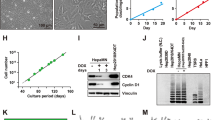Abstract
Human liver tissue slices, homogenates, organ cultures, subcellular fractions and primary hepatocyte cultures represent valuable tools for analysis of metabolism, toxicity and efficacy of xenobiotics. However, the limited access to human tissue and the high test variability with different tissue isolates underline the significance of having standardized and defined human liver cell models. This report describes the establishment of replicative cultures of human liver epithelial cells and their immortalization in serum-free medium. Highly efficient immortalization is achieved by the infection of primary liver cells with a retroviral recombinant carrying the simian virus 40 (SV40) large T antigen gene. These cultures have an indefinite life-span, are non-tumorigenic and express differentiation markers and metabolic functions of normal primary hepatocytes. Therefore, these cells are useful for various pharmaco-toxicological applications.
Similar content being viewed by others
Abbreviations
- LCM:
-
live cell medium
- SV40:
-
Simian virus 40
References
Barnes D, Sato G (1980). Methods for growth of cultured cells in serum-free medium. Anal Biochem 102: 255–270.
Berry MN, Friend DS (1969). High yield preparation of isolated rat liver parenchymal cells. J Cell Biol 43: 506–520.
Bestwick RK, Kozak SL, Kabat D (1988). Overcoming interference to retroviral superinfection results in amplified expression and transmission of cloned genes. Proc Natl Acad Sci USA 85: 5404–5408.
Cepko CL, Roberts BE, Mulligan RC (1984). Construction and applications of a highly transmissible murine retrovirus shuttle vector. Cell 37: 1053–1062.
Chen C, Okayama H (1987). High efficiency transformation of mammalian cells by plasmid DNA. Mol Cell Biol 7: 2745–2752.
Evarts RP, Nagy P, Nakatsukasa H, Marsden E. Thorgeirsson SS (1989). In vivo differentiation of rat liver oval cells into hepatocytes. Cancer Res 49: 1541–1547.
Harris CC (1987). Human tissues and cells in carcinogenesis research. Cancer Res 47: 1–10.
Hsu IC, Lipsky MM, Cole KE, Su CH, Trump BF (1985). Isolation and culture of hepatocytes from human liver of immediate autopsy. In Vitro Cell Develop Biol 21: 154–160.
Kaighn ME, Prince AM (1971). Production of albumin and other serum proteins by clonal cultures of normal human liver. Proc Natl Acad Sci USA 68: 2396–2400.
Lechner JF, Babcock MS, Marnell MM, Narayan KS, Kaighn ME (1980). Normal human prostate epithelial cell cultures. In: Harris CC, Trump BF, Stoner GD (eds), Methods in Cell Biology. New York: Academic Press, pp 195–225.
Lechner JF, Cole KE, Reddel RR, Anderson L, Harris CC (1989). Replicative cultures of adult human and rhesus monkey liver epithelial cells. Cancer Detec Prev 14: 239–244.
Lechner JF, La Veck MA (1985). A serum-free method for culturing normal human bronchial epithelial cells at clonal density. J Tissue Culture Methods 9: 43–48.
Mann R, Mulligan RC, Baltimore D (1983). Construction of a retrovirus packaging mutant and its use to produce helper-free defective retrovirus. Cell 33: 153–159.
Miller AD, Buttimore C (1986). Redesign of retrovirus packaging cell line to avoid recombination leading to helper virus production. Mol Cell Biol 6: 2895–2902.
Miyazaki M, Namba M (1991). Liver cell cultures and their utilization for hepatocarcinogenesis. Okayam Igakkai Zasshi 103: 337–348.
Pfeifer AMA, Cole K, Smoot DT, Weston A, Groopman JD, Shields PG, Vignaud J-M, Juillerat M, Lipsky MM, Trump BF, Lechner JF, Harris CC (1993). Simian virus 40 large tumor antigen-immortalized normal human liver epithelial cells express hepatocyte characteristics and metabolize chemical carcinogens. Proc Natl Acad Sci USA 90: 5123–5127.
Thorgeirsson SS, Evarts RP (1992). Growth and differentiation of stem cells in adult rat liver. In: Sirica (ed), The role of cell types in hepatocarcinogenesis. Boca Raton: FL. CRC Press, 109–120.
Author information
Authors and Affiliations
Rights and permissions
About this article
Cite this article
Pfeifer, A.M.A., Mace, K., Tromvoukis, Y. et al. Highly efficient establishment of immortalized cells from adult human liver. Methods Cell Sci 17, 83–89 (1995). https://doi.org/10.1007/BF00986655
Accepted:
Issue Date:
DOI: https://doi.org/10.1007/BF00986655




